Aquila constellation is located in the northern sky, on the celestial equator. The constellation’s name means “the eagle” in Latin. The constellation represents the eagle of the god Jupiter in Roman mythology. It was first catalogued by the Greek astronomer Ptolemy in the 2nd century.
The Eagle constellation is easy to spot, flying opposite the celestial Swan (Cygnus). Altair, the constellation’s brightest star, forms a prominent asterism known as the Summer Triangle with the luminaries of Cygnus (Deneb) and Lyra (Vega).
Aquila is home to Altair, the 12th brightest star in the sky and one of our nearest bright neighbours, Tarazed (Gamma Aquilae), an orange bright giant, and Eta Aquilae, a variable white supergiant. The constellation also contains several interesting deep sky objects: the planetary nebulae NGC 6803, NGC 6804, NGC 6781, the Glowing Eye Nebula (NGC 6751), and the Phantom Streak Nebula (NGC 6741), the open clusters NGC 6709 and NGC 6755, and the dark nebula B143-4.
Facts, location and map
Aquila is the 22nd biggest star constellation in the sky, occupying an area of 652 square degrees in the fourth quadrant of the northern hemisphere (NQ4). It can be seen at latitudes between +90° and -75°. The neighboring constellations are Aquarius, Capricornus, Delphinus, Hercules, Ophiuchus, Sagitta, Sagittarius, Scutum, and Serpens Cauda.
The constellation name Aquila is pronounced /ˈækwɪlə/. In English, the constellation is known as the Eagle. The genitive form of Aquila, used in star names, is Aquilae (pronunciation: /ˈækwɪliː/). The three-letter abbreviation, adopted by the International Astronomical Union (IAU) in 1922, is Aql.
Aquila is one of the 15 equatorial constellations. It has three stars brighter than magnitude 3.00 and two stars located within 10 parsecs (32.6 light years) of Earth. The brightest star in the constellation is Altair, Alpha Aquilae (spectral class A7 V), which is also the 12th brightest star in the sky. Altair is also the nearest star in Aquila, at a distance of only 16.77 light years from Earth.
Aquila has nine stars with known planets. HD 179079, a G-type subgiant (G5IV), has an orbiting planet that was discovered in 2009. HD 183263 (G2IV) has two planets, discovered in 2005 and 2008. Xi Aquilae, a red clump giant (G9 III) also known by the name Libertas, has a confirmed exoplanet, named Fortitudo, that was discovered in 2008. A planet orbiting the star HD 192263, an orange dwarf (K2V), was discovered on September 28, 1999, and one orbiting the yellow subgiant HD 192699 (G8IV) was announced in April 2007. Other stars with confirmed planets include COROT-10 (K1V) and COROT-8 (K1V).
Aquila contains ten named stars. The proper names of stars that have been officially approved by the International Astronomical Union (IAU) are Alshain, Altair, Antinous, Chechia, Libertas, Okab, Petra, Phoenicia, Tarazed, and Tianfu.
Aquila does not contain any Messier objects. There are two meteor showers associated with the constellation: the June Aquilids and the Epsilon Aquilids.
Aquila belongs to the Hercules family of constellations, together with Ara, Centaurus, Corona Australis, Corvus, Crater, Crux, Cygnus, Hercules, Hydra, Lupus, Lyra, Ophiuchus, Sagitta, Scutum, Serpens, Sextans, Triangulum Australe, and Vulpecula.
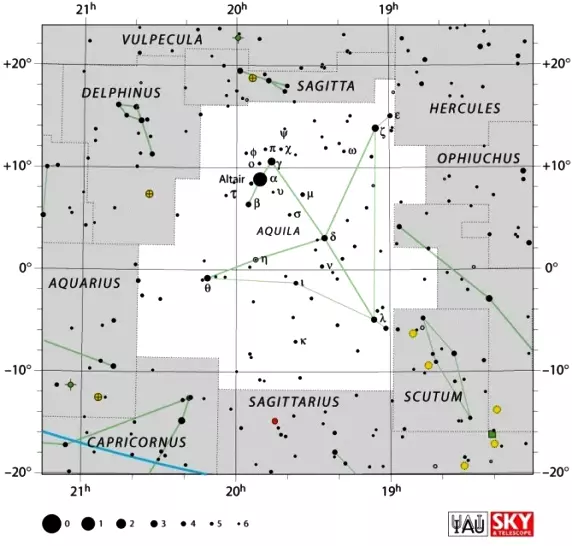
Aquila constellation map, by IAU and Sky&Telescope magazine
Aquila myth
In Greek mythology, Aquila is identified as the eagle that carried Zeus’ thunderbolts and was once dispatched by the god to carry Ganymede, the young Trojan boy Zeus desired, to Olympus to be the cup bearer of the gods. Ganymede is represented by the neighbouring constellation Aquarius.
In another story, the eagle is found guarding the arrow of Eros (represented by the constellation Sagitta), which hit Zeus and made him love-struck.
In yet another myth, Aquila represents Aphrodite disguised as an eagle, pretending to pursue Zeus in the form of a swan, so that Zeus’ love interest, the goddess Nemesis, would give him shelter. In the story, Zeus later placed the images of the eagle and the swan among the stars to commemorate the event.
The name of the brightest star in the constellation, Altair, is derived from the Arabic al-nasr al-ta’ir, which means “flying eagle” or “vulture.” Ptolemy called the star Aetus, which is Latin for “eagle.” Similarly, both Babylonians and Sumerians called Altair “the eagle star.”
Major stars in Aquila
Altair – α Aquilae (Alpha Aquilae)
Altair is the 12th brightest star in the sky, with an apparent magnitude of 0.77. It is an A-type main sequence star (hydrogen fusing dwarf) that has three visual companions. Lying only 16.8 light-years away, Altair is one of the closest stars to Earth that is visible to the unaided eye. The star’s name is derived from the Arabic phrase an-nasr at-ta’ir, which means “the flying eagle.”
Altair has 1.8 times the mass of the Sun. Because it rotates very rapidly (286 km/s at the equator), Altair’s shape is not spherical, but flattened at the poles. The star also moves across the sky relatively quickly. It shifts by about a degree in 5000 years.
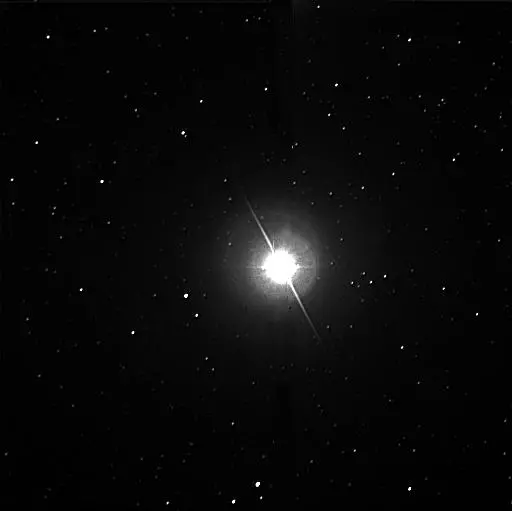
The star Altair. Image: NASA/JPL/Caltech/Steve Golden
Altair is one of the three stars that form the Summer Triangle, an asterism that can be seen directly overhead at mid-northern latitudes in the summer. Altair is the southern star in the triangle. The other two stars that form the asterism are Deneb (Alpha Cygni) in the constellation Cygnus and Vega (Alpha Lyrae) in Lyra.
Alshain – β Aquilae (Beta Aquilae)
Alshain is only the seventh brightest star in Aquila, but was designated Beta Aquilae nonetheless by Johann Bayer. It is a class G subgiant approximately 44.7 light years distant.
The name Alshain is derived from the Perso-Arabic aš-šāhīn, which means “the (peregrine) falcon.” The star has a 12th magnitude visual companion, Beta Aquilae B, a class M red dwarf, lying 13 arc seconds away. Alshain is six times more luminous than the Sun and slightly variable in luminosity. It has an apparent magnitude of 3.71.
Tarazed – γ Aquilae (Gamma Aquilae)
Tarazed is the second brightest star in Aquila. Its name is derived from the Persian phrase šāhin tarāzu, which means “the beam of the scale.” It is a class K (spectral class K3) bright giant with an apparent magnitude of 2.72, approximately 461 light years distant.
Tarazed is 2960 times more luminous than the Sun and has a radius of 110 solar, taking up about half an AU in the sky. It is a known source of X-rays. Tarazed is about 100 million years old and yet it is already burning helium into carbon in its core.
Deneb el Okab – ε Aquilae (Epsilon Aquilae)
Epsilon Aquilae, or Deneb el Okab, is a triple star system about 154 light years distant. Its name is derived from the Arabic phrase ðanab al-cuqāb, which means “the tail of the eagle.” The brightest component of Epsilon Aquilae is an orange K-type giant which is a known barium star; one containing a lot of barium and other heavy elements. Epsilon Aquilae has an apparent magnitude of 4.02. The companions, suspected optical binaries, are 10th magnitude stars.
To differentiate Epsilon from Zeta Aquilae, which is also called Deneb el Okab, Epsilon Aquilae is often referred to as Deneb el Okab Borealis, because it is located north of Zeta Aquilae, which is subsequently referred to as Deneb el Okab Australis.
Deneb el Okab – ζ Aquilae (Zeta Aquilae)
Zeta Aquilae is another triple star system, approximately 83.2 light years distant, with a white A-type main sequence dwarf for a primary. The main star has an apparent magnitude of 2.99, while the companions are 12th magnitude stars.
Bezek – η Aquilae (Eta Aquilae)
Eta Aquilae is a yellow-white supergiant, approximately 1200 light years from Earth. It is a Cepheid variable star, with its apparent magnitude varying between 3.5 and 4.4 with a period of 7.176641 days. Eta Aquilae is one of the easiest Cepheids to distinguish by the unaided eye. The star is 3000 times more luminous than the Sun. The name Bezek comes from the Hebrew word bazak, which means “lightning.”
Antinous – θ Aquilae (Theta Aquilae)
Theta Aquilae is a spectroscopic binary star about 286 light years distant. It has an apparent magnitude of 3.26. Both components in the system are hot blue giants of the spectral type B9.5 III. They are separated by only 3.2 milliarcseconds in the sky, corresponding to a physical separation of 0.24 – 0.28 astronomical units (Earth – Sun distances). The system has an estimated age of only 20.9 million years.
In 2024, the International Astronomical Union (IAU) approved the name Antinous for the primary component. Antinous was the name of an ancient constellation that commemorated the Roman emperor Hadrian’s lover. It was created during Hadrian’s reign in 132 CE and merged into Aquila in the 19th century.
The traditional name of Theta Aquilae, Tseen Foo, is derived from the Mandarin word tianfu, which means “the heavenly rafter” and also “drumsticks.” The Chinese called the asterism formed by Theta Aquilae with 62 Aquilae, 58 Aquilae and Eta Aquilae the Celestial Drumsticks.
Al Thalimain – ι Aquilae (Iota Aquilae)
Iota Aquilae is a blue-white B-type star approximately 307 light years distant. The name Al Thalimain, which the star shares with Lambda Aquilae, means “the two ostriches” in Arabic. Iota Aquilae has an apparent magnitude of 4.36.
Al Thalimain – λ Aquilae (Lambda Aquilae)
Lambda Aquilae, a blue-white B-type main sequence dwarf, is sometimes called Al Thalimain Prior, to differentiate it from Iota Aquilae. The star has an apparent magnitude of 3.43 and is 125 light years distant.
In 1973, NASA launched the probe Pioneer 11 that will presumably approach Lambda Aquilae in about four million years (if all goes well). The probe left the solar system in 1990 and, because its power was too weak, it has not transmitted any data since 1995.
15 Aquilae
15 Aquilae is a magnitude 5 orange giant that has a faint optical companion, HD 177442. The star is approximately 289 light years distant and easy to observe in small telescopes.
Tso Ke – ρ Aquilae (Rho Aquilae)
Rho Aquilae is a white A-type main sequence dwarf, approximately 154 light years distant. It has an apparent magnitude of 4.94. The star’s traditional name, Tso Ke, comes from Mandarin and means “the left flag.” The star no longer belongs to the constellation Aquila, as it crossed the border into Delphinus in 1992.
Tianfu – τ Aquilae (Tau Aquilae)
Tau Aquilae is an evolved orange giant star located approximately 549 light-years away. It has an apparent magnitude of 5.6799 and is faintly visible to the unaided eye.
The star has a radius 21.24 times that of the Sun and shines with 207.9 solar luminosities. It has a surface temperature of 4,756 K.
In 2024, the International Astronomical Union (IAU) approved the name Tianfu for the star. Tianfu (天桴) is the name of an ancient Chinese constellation that included Tau Aquilae.
Deep sky objects in Aquila
Phantom Streak Nebula – NGC 6741
NGC 6741 is a planetary nebula first discovered in 1882 by the American astronomer Edward Charles Pickering. The nebula is approximately 7000 light years distant and has an apparent magnitude of 11. It is quite small in size, occupying an area of 0.1 arcminutes of the apparent sky.
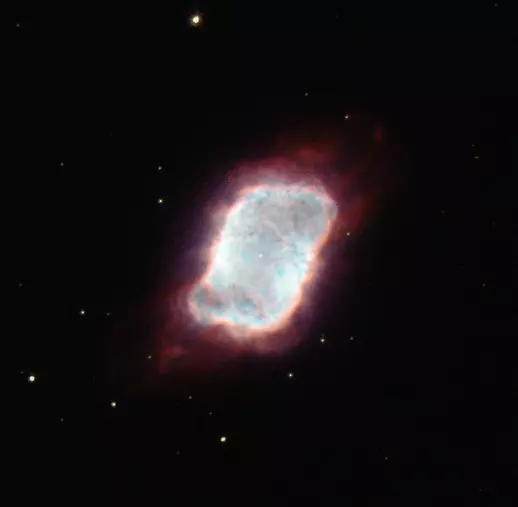
Phantom Streak Nebula, image: ESA/Hubble and NASA
NGC 6709
NGC 6709 is an open star cluster that can be easily resolved in a small telescope. It lies five degrees southwest of the star Zeta Aquilae. The stars in the cluster are loosely arranged into a diamond-like shape. The cluster was discovered by William Herschel on 19 July, 1828.
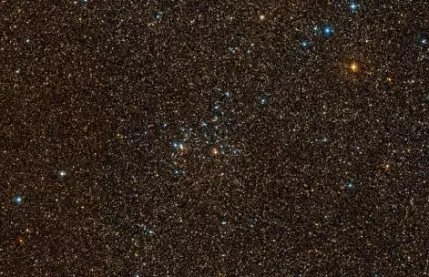
NGC 6709, image: Wikisky
E Nebula – Barnard 142 and 143
The E Nebula, also known as Barnard’s E Nebula, consists of two dark nebulae – Barnard 142 and 143 – located 1.5 degrees west of Tarazed, Gamma Aquilae. The E Nebula is about 0.5 degrees across, or roughly the size of the full Moon. It lies at an estimated distance of 2,000 light years from Earth.
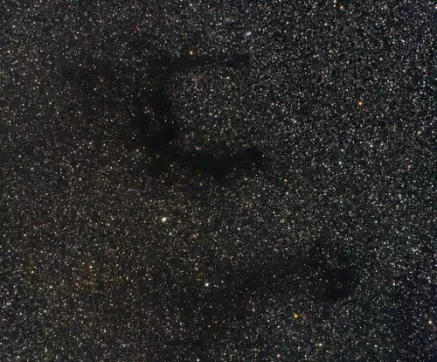
Barnard’s E Nebula, image: Wikisky
NGC 6755
NGC 6755 is another open cluster in Aquila. The brightest stars in it are of 12th and 13th magnitude. The cluster lies at a distance of 4632.46 light years from Earth and can be seen 4.5 degrees west of the star Delta Aquilae. It has an apparent magnitude of 7.5 and an apparent size of 15′.
NGC 6781
NGC 6781 is another planetary nebula, somewhat similar in appearance to the Owl Nebula (Messier 97) in the constellation Ursa Major. It is also often compared to the famous Ring Nebula (Messier 57), located in Lyra constellation.
NGC 6781 has an apparent magnitude of 11.4, an apparent diameter of 1.8′ and a linear diameter of about 2 light years. Its central star, a white dwarf, has an apparent magnitude of 16.8.
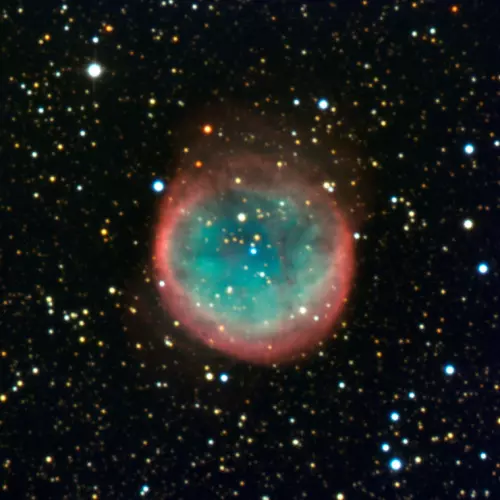
NGC 6781 photographed by the ESO 3.6-m Telescope, using the Faint Object Spectrograph and Camera (EFOSC2), at the La Silla Observatory in the Atacama Desert, Chile. Image: ESO
The nebula was discovered by William Herschel on July 30, 1788. It is located at an approximate distance of 2,500 light years.
NGC 6803
NGC 6803 is a planetary nebula with a visual magnitude of 11.4. It was discovered by Edward Charles Pickering on September 17, 1882. It is less than an arc minute away from NGC 6804.
NGC 6804
NGC 6804 is another planetary nebula in Aquila. It has an apparent magnitude of 12.0 and occupies an area about 1.1 by 0.8 arc minutes in size. It lies at an approximate distance of 4,200 light years. The central star has an apparent magnitude of 14.4. The nebula was discovered by William Herschel on August 25, 1791.
The Glowing Eye Nebula – NGC 6751
NGC 6751, also known as the Glowing Eye Nebula, is a planetary nebula about 0.8 light years in diameter, which is about 600 times the size of the solar system. In April 2000, an image of the nebula was selected to commemorate the 10th anniversary of the Hubble Space Telescope in orbit.
The Glowing Eye lies at an approximate distance of 6,500 light years from Earth and has a visual magnitude of 11.9. It can be seen 1.1 degrees south of the star Lambda Aquilae. The nebula occupies 0.43′ of the apparent sky. It expands at a speed of 40 km/s.
The central star has an estimated surface temperature of 140,000° C and an apparent magnitude of 13.9.
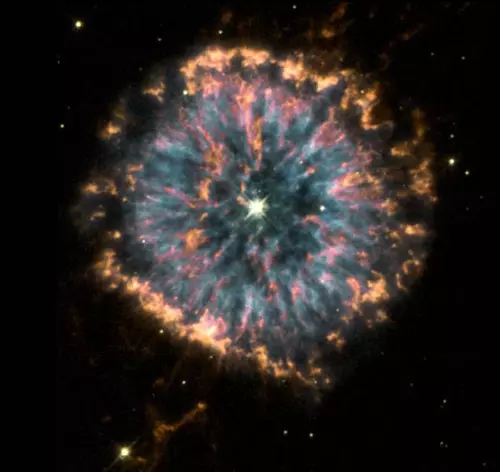
The Glowing Eye Nebula (NGC 6751), image: NASA, The Hubble Heritage Team (STScI/AURA)
NGC 6760
NGC 6760 is a globular cluster with an apparent magnitude of 9.0 and an apparent size of 9.6′. It is located at a distance of 24,100 light years from Earth. The cluster was discovered by John Russell Hind on March 30, 1845. John Herschel catalogued it as GC 4473 and John Louis Emil Dreyer added it to the New General Catalogue as NGC 6760.
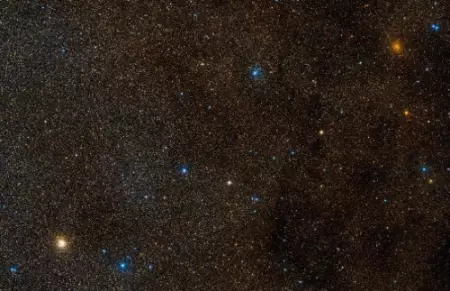
NGC 6760 (bottom left) and NGC 6749 (top right), image: Wikisky
NGC 6749
NGC 6749 is another globular cluster in Aquila, discovered by John Herschel on July 15, 1827. The cluster has an apparent magnitude of 12.4. It can be seen only 1.72 arc minutes away from NGC 6760.
NGC 6778
NGC 6778 (also catalogued as NGC 6785) is a planetary nebula with a visual magnitude of 12.3, located at an approximate distance of 3,200 light years from Earth. It is a bipolar nebula with a highly disrupted equatorial ring. The central star is a binary system with a short orbital period.
NGC 6778 was discovered by John Herschel on May 21, 1825 and independently by Albert Marth on June 25, 1863, which led to the nebula’s double listing in the New General Catalogue. The nebula lies only 0.04 arc minutes away from the open cluster IC 1298 and 0.79 arc minutes from the cluster NGC 6775.
IC 1298
IC 1298 is an open cluster in Aquila. It was discovered by Guillaume Bigourdan on July 30, 1889.
NGC 6772
NGC 6772 is a planetary nebula with a visual magnitude of 12.7. It can be seen 1.46 arc minutes from NGC 6778. It was discovered by William Herschel on July 21, 1784.